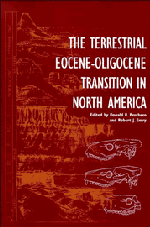Book contents
- Frontmatter
- Contents
- Contributors
- Preface
- PART I The Chronostratigraphy of the Uintan through Arikareean
- PART II Common Vertebrates of the White River Chronofauna
- 16 Testudines
- 17 Squamata
- 18 Ischyromyidae
- 19 Cylindrodontidae
- 20 Castoridae
- 21 Canidae
- 22 Nimravidae
- 23 Amphicyonidae
- 24 Small Arctoid and Feliform Camivorans
- 25 Merycoidodontinae and Miniochoerinae
- 26 Leptaucheniinae
- 27 Leptomerycidae
- 28 Camelidae
- 29 Hyracodontidae
- Summary
- Index
21 - Canidae
Published online by Cambridge University Press: 06 July 2010
- Frontmatter
- Contents
- Contributors
- Preface
- PART I The Chronostratigraphy of the Uintan through Arikareean
- PART II Common Vertebrates of the White River Chronofauna
- 16 Testudines
- 17 Squamata
- 18 Ischyromyidae
- 19 Cylindrodontidae
- 20 Castoridae
- 21 Canidae
- 22 Nimravidae
- 23 Amphicyonidae
- 24 Small Arctoid and Feliform Camivorans
- 25 Merycoidodontinae and Miniochoerinae
- 26 Leptaucheniinae
- 27 Leptomerycidae
- 28 Camelidae
- 29 Hyracodontidae
- Summary
- Index
Summary
ABSTRACT
The White River Group of the late Eocene and Oligocene age contains some of the earliest and most primitive canids in North America. These archaic canids, mainly Hesperocyon and its close relatives, gave rise to several clades that contain ancestral forms for all three subfamilies of the Canidae: the paraphyletic Hesperocyoninae which became the dominate canids during the Arikareean, the monophyletic Borophaginae which flourished during the Miocene, and the monophyletic Caninae which did not diversify until Pliocene through Recent time. The middlelate Eocene (Duchesnean to Chadronian) saw the emergence of the first canids with a fully ossified entotympanic bulla and canid dentition (3 1 4 2/3 1 4 3), as represented by Prohesperocyon wilsoni and H. gregarius, which probably evolved from primitive cynoids such as Procynodictis. The White River canids began an initial diversification in the beginning of Oligocene (Orellan), giving rise to the earliest members of the borophagine (Cormocyon) and canine (Leptocyon) clades. At least six species can be recognized at this time: H. gregarius, “H.” coloradensis, “Mesocyon” temnodon, Osbornodon renjiei, Cormocyon pavidus, and Leptocyon sp. In Whitneyan time, the majority of the hesperocyonine clades began to be readily distinguishable, and the borophagines began to develop small, hypocarnivorous taxa. The number of species in the Whitneyan had increased to nine: H. gregarius, Paraenhydrocyon josephi, “M.” temnodon, Cynodesmus thooides, Osbornodon renjiei, O. Sesnoni, Ectopocynus antiquus, Cormocyon pavidus, and Oxetocyon cuspidatus.
- Type
- Chapter
- Information
- The Terrestrial Eocene-Oligocene Transition in North America , pp. 433 - 452Publisher: Cambridge University PressPrint publication year: 1996
- 7
- Cited by



